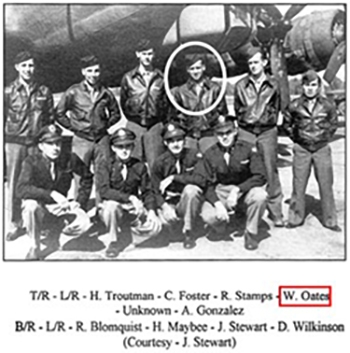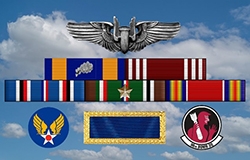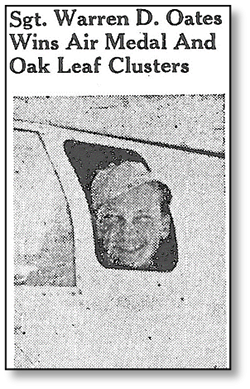Staff Sergeant Warren Durward Oates
United States Army Air Forces, World War II
Tail Gunner, B-17 #42-5777, 96th Bomb Squadron, 2nd Bomb Group

April 8, 2021 - During the heat of summer, August 25, 1923 Warren Durward Oates was born in Shelby County, Texas that can be found in the far east part of the state. His parents, both native Texans were Mary Susan Eddins and James Oates who were married in Shelby County on September 24, 1903. Warren was the baby of the family with five older siblings, Jewel, Annie Victoria, Steven William, Primrose and James R. Unfortunately it appears his parents’ marriage ended in the late 1920’s and the children then lived with Susan on a farm in rural Shelby County.
With the Japanese attack on the US Military Installations at Pearl Harbor, Hickam and Wheeler Fields, Hawaii, December 7, 1941, the United States found itself embroiled in a second World War. Warren now 18 years old complied with the Selective Service Act of 1940 and registered for the military draft in Beaumont, Texas on June 30, 1942. His registration card, D.S.S. Form 1 showed; his residence was at 1159 Liberty Street, Beaumont where he lived with his mother Susan; employed by Lumes Construction Company, Port Arthur; was five foot nine and one-half inches tall and weighed 156 pounds; gray eyes, blonde hair and light complexed.(1)
Seven months later on January 29, 1943 Warren voluntarily enlisted in the US Army Air Forces. Following basic training Private Oates was assigned as an aerial gunner and was required to attend a flexible gunnery school that lasted nine weeks. The students learned how to strip down the .50 caliber machine gun, reassemble, load it, clear jams and of course fire it effectively to protect their bomber against enemy fighter attacks with machine guns aimed by hand (“flexible guns”) and electrically-powered gun turrets. Typically, gunners made up half of a bomber crew, manning a top turret, ball turret, two waist guns, and a tail turret. Training at Las Vegas, Nevada he graduated and received his Gunnery Wings on August 23, 1943.

After a furlough home to see the folks, newly promoted Staff Sergeant Warren Durward Oates was assigned to the 96th Bomb Squadron of the 2nd Bombardment Group (Heavy), Fifteenth Air Force. He departed for Amendola Air Base in Foggia, Italy in December 1943 where he was placed with the crew of Flying Fortress Bomber B-17 # 42-5777, nicknamed “The Gin Mill” as the tail gunner. Other members of the crew were; Pilot, Second Lieutenant Richard M. Blomquist; Co-Pilot, Second Lieutenant Harper C. Maybee; Navigator Second Lieutenant James S. Stewart; Bombardier, Second Lieutenant Dale E. Wilkinson; Engineer, Staff Sergeant Harold A. Troutman; Radio Operator, Staff Sergeant Robert B. Stamps; Gunners, Sergeants Benjamin F. Sheckles, Jr., Carl R. Foster and Ascension Gonzalez, Jr.(2)

Aerial Gunner Wings, Air Medal with Silver Oak Leaf Cluster,
Army Good Conduct Medal, American Campaign Medal,
European-Africian-Middle Eastern Campaign Medal,
World War II Victory Medal, Presidential Unit Citation.
The Champion Newspaper, Center, Shelby County, Texas, July 24, 1944 reported that Warren and crew of The Gin Mill flew their first combat mission over Villaorba, Italy on January 16, 1944. They were part of sixty-one B-17s from the Second and Ninety-Ninth Bomb Groups that bombed the landing field at Villaorba without opposition and were escorted to and from the target by forty-six P-47s. Their bombs cratered the entire field and damaged dispersal areas and railroad tracks.(3) In the Twelfth Air Force the “check point” for rotation back to the states was fifty missions. Five months later, June 13, 1944 Staff Sergeant Oates flew his fiftieth mission over Munich, Germany that qualified him to rotate back to the United States.
To just say “he completed fifty missions” and go on would be a gross injustice to his memory and the sacrifice Warren and his fellow flying comrades made during World War II. Looking at the numbers that were printed in a newspaper article and may or may not be 100% accurate, he finished his fifty in 149 days which would require flying combat missions every three days. Burn out or combat fatigue was very common and a real problem from the beginning with combat crews. Consider this, all at the age of twenty years; missions that penetrated deep into enemy territory could last up to eight hours and be filled with many anxious moments looking for enemy fighter planes that wanted to kill you and the rest of the crew; going through heavy antiaircraft fire from the ground; the planes were unheated and open to outside air; the crew wore electrically heated suits and heavy gloves that provided some protection against temperatures that could dip to 60 degrees below; reaching 10,000 feet oxygen masks were required as the plane climbed to operational levels that could be as high as 29,000 feet; as they neared the target each crew member would put on a 30-pound flak suit and steel helmet designed to protect them again antiaircraft fire; parachutes were too bulky to be worn all of the time, but crewmen did wear a harness that allowed them to quickly clip on their parachute when needed; prior to 1944 the tour of duty was 25 missions and it was estimated the average crewman had only a one in four chance of actually completing his tour.(4) Try doing this every three days!
After each mission the crews were debriefed about what went on and what they saw during the mission. Those who were eyewitnesses to events such as what happened to other planes in the formation gave signed statements for the record. At Fold3.com four such statements by Staff Sergeant Warren Oates were found. One can only imagine the nightmares and sleepless nights these sights could cause.
1. February 17, 1944: Statement of S/Sgt Warren D. Oates, 38414283, tail gunner of B-17 No. 42-5777, 96th Squadron, which was flying in the second wave, second squadron, first element, third plane.
“I was calling out fighters to the rest of our crew when I noticed that B-17 No. 067 was heading straight down. This B-17 was on fire at this time with long trails of flame going over the wing. I am quite sure No. 2 engine was on fire and seemed to be spreading. When about 3,000 feet below our formation, I saw five (5) chutes come out of this plane, one right after the other. The plane was still heading straight down after the last chute was seen to come out. A very short time after this I saw the plane hit the ground and explode.” (https://www.fold3.com/image/28613358)
2. February 25, 1944: Statement of S/Sgt Warren D. Oates, 38414283, tail gunner on B-17 No. 42-5777, 96th Squadron, flying in the second wave, first squadron, second element, second plane.
“Plane No. 42-31390 was still in formation in the second squadron until about six or seven minutes before bombs away. It then burst into flame between No. 3 and No. 4 engines and immediately went into a dive. I happened to be tracking a fighter in his direction as No. 390 went down and had a chance to see it most of the way down. I don’t believe any of the men got out”. (https://www.fold3.com/image/28737721)
3. April 14, 1944: Statement of S/Sgt Warren D. Oates, 38414285, tail gunner on B-17 No. 652, flying in the first wave, first squadron, first element, number two position.
“The fighters made a pass at the rear of our group shortly after our bombs were away, but before those of the second wave, were away. I noticed the silver aircraft (B-17 No. 058) wobble his wings, perhaps to show that he was going to leave the formation, and I noticed a fire in the number three engine. He started angling off to the right a bit and losing altitude. As he got a little distance from the formation, the chutes started coming out and he made a 360 degree circle. I counted seven (7) chutes come out while he was making this circle, and then I lost sight of him.” (https://www.fold3.com/image/29635444)
4. April 17, 1944: Statement of S/Sgt Warren D. Oates, 38414283, tail gunner of B-17 No. 006 flying in the second wave, third squadron, second element, first position.
“B-17 No. 581 had been flying on our left wing since B-17 No. 069 turned back and we had taken the lead of the element. It apparently was having no difficulty in staying in position until the formation made a left turn at 1127 hours. He then started falling back and dropped back behind number four squadron the last at that time. He opened his doors and salvoed his bombs at 1129 hours just as we were straightening out from the turn. After he salvoed his bombs, he caught up a little, but he never did get back in formation. At 1152 hours, when we saw flak from Caransebee, I noticed B-17 No. 581 out at 4 o’clock low with all four engines going. Just after we made a right turn. This caused B-17 No. 581 to go under the formation where I couldn’t see him, and I never saw him again.” (https://www.fold3.com/image/28632163)
 The Champion Newspaper of July 24, 1944 reported Warren had been awarded the Air Medal with six oak leaf clusters for successful completed missions over enemy territory and was spending a 20 day furlough with his mother, Mrs. Susan Oates in Center. Information about his military service from then to honorable discharge on September 14, 1945 is lacking but in all probability Warren with his combat experience would have been assigned to help train new bomber crews in the United States.
The Champion Newspaper of July 24, 1944 reported Warren had been awarded the Air Medal with six oak leaf clusters for successful completed missions over enemy territory and was spending a 20 day furlough with his mother, Mrs. Susan Oates in Center. Information about his military service from then to honorable discharge on September 14, 1945 is lacking but in all probability Warren with his combat experience would have been assigned to help train new bomber crews in the United States.
Returning to civilian life, he married Myrtle Louis Blackmore. They had two known sons, Michael Dean and James Reed. At the age of 52, Warren passed at the Jasper Memorial Hospital, Jasper, Texas of a heart attack on February 19, 1976. He had been employed a carpenter in the construction industry. Funeral arrangements were by Griner Funeral Home, Newton, Texas. Warren Durward Oates, a member of that “Greatest Generation” was laid to rest in the Spears Chapel Cemetery, Burkeville, Newton County, Texas. Day is done, God is nigh.
References:
(1) The National Archives in St. Louis, Missouri; St. Louis, Missouri; WWII Draft Registration Cards for Texas, 10/16/1940-03/31/1947; Record Group: Records of the Selective Service System, 147; Box: 1112
(2) Richards, Charles. The Second Was First. Maverick Publications, Inc. Accessed February 21, 2021. http://www.2ndbombgroup.org/Books.htm.
(3) Mahoney, Kevin A.. Fifteenth Air Force Against the Axis: Combat Missions Over Europe During World War II. United States: Scarecrow Press, 2013.
(4) “Life and Death Aboard a B-17, 1944.” Accessed February 22, 2021. http://www.eyewitnesstohistory.com/b17.htm#:~:text=Life%20and%20Death%20Aboard%20a%20B%2D17%2C%201944&text=America%20joined%20Britain’s%20strategic,entrance%20into%20World%20War%20Two.









